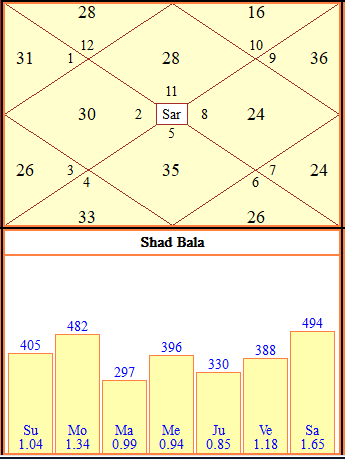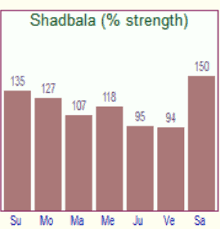
Have you ever seen planets in the night sky? Don’t they look like shining dots in the darkness just like stars? But they will never be seen in the daylight because of the brightness of the sun. In fact, they are visible in the evening because of the sun receding into darkness. Moreover, they are not only visible because of the hiding of the sun but also because they are at a good distance from the sun. Hence, the bright light from the sun does not cover them rather glorifies them. This decides Istha Phala and Kastha Phala for earthly lives.
Description
The speed of the planets and their distance from the sun decides what will be their influence on life over the earth. This influence can be good or bad depending on their position and aspect to earth. The good attributes of the planets on the basis of distance from sun and speed are called Istha Phala(IP), while the bad attributes are Kastha Phala(KP). However, these attributes are to be calculated by using Astro-Vedic calculation methods.
Calculation Methods
‘Shad-Bala’ is a quantitative analysis method of planetary strength in Vedic astrology. ‘Shad’ means ‘6’ in Sanskrit, there are 6 main criteria for assessing a planet’s strength. Shad-Bala does not calculate the planetary strengths of Rahu & Ketu. Points or ‘Shastiamsa’ are assigned to the planets to assess their strength.
Criteria of Shad-Bala

The 6 main criteria are as follows:
1. Sthana Bala – It is the strength of planets due to position. In addition, it has 5 criteria: i) Uccha Bala, ii) Saptavargaja Bala, iii) Ojayyugma Bala, iv)Kendra Bala, v)Drekkana Bala
2. Dig Bala: Calculated by placement relative to the Kendra houses.
3. Kala Bala: Calculated by the time of the day when you were born. In addition, it makes the use of 9 Bala, namely Divaratri, Paksha, Tri-Bhaga, Abda, Masa, Vara, Hora, Ayana, and Yuddha.
4. Chesta Bala: It is the calculation of IP and KP based on their velocity. Faster moving planets get fewer points and slower planets get more points. You decide velocity by comparing it with the planet’s own average speed and not with other planets.
5. Naisargika Bala: The basis of this calculation is on the luminosity of th planets. This value remains since the luminosity of the planets doesn’t change.
6. Drik Bala: Calculated based on aspects of malefic/benefic planets, including partial aspects. A positive value shows more benefic influence on the planet & negative value shows otherwise.
Formulae

Uccha Bala’ & ‘Chesta Bala are 2 main components of Shad-Bala. ‘Uccha Bala‘ is an observation of a planet’s position relative to its exaltation & debilitation points. Nearer the planet to its exaltation point, more will be its points in Uccha-Bala. ‘Chesta Bala‘ is a comparison of a planet’s instantaneous relative velocity with its average velocity. Planets with a lower relative velocity score higher. This is because slow-moving planets are able to focus their energy more.
Formulae for finding Ishta & Kashta Phalas are:
Ishta-Phala = SQRT(Uccha bala*Chesta Bala)
Kashta-Phala = SQRT[(60-Uccha Bala)*(60-Chesta Bala)
Important Features Of IP & KP
These features depend on 2 main points – 1) Distance from the sun, and 2) Distance from Point of Exaltation. In fact, the higher the distance from the sun higher will be IP and the lower the distance lower will be the IP. Similarly, the closer a planet is to its exaltation point, higher will be its IP and vice-versa.

1) They are a part of standard Shadbala calculation for a planet’s strength.
2) The mathematical result obtained varies from an absolute number of 0 – 60. 60 is the highest IP for any planet and 0 is the lowest.
3) These calculations exclude Rahu-Ketu.
4) During the Dasa period, the high IP planets provide their benefits easily while KP planets add to hindrances in the native’s life.
5) If a benefic planet has low IP, during its Dasa period, its results will be good but have initial hiccups.
6) If a malefic planet also has low IP during its Dasa, the results will be grave circumstances. It can even destroy all significations of houses it rules, sits in and aspects.
7) Besides, the planet, IP of the Rashi is also important. In case, a planet is deposited in a Rashi or Nakshatra of a planet with a high IP and low KP, then this planet will have a lot of good/ benefic results.
8) Good Yogas occurs in signs and nakshatras of planets with high IP and low KP. While planets with low IP and high KP, have weak Yogas and accompany initial damages.
9) General benefic planets like Jupiter, Venus, Moon & Mercury have higher IP while natural malefic planets like Saturn, Mars & Sun have lower IP.













